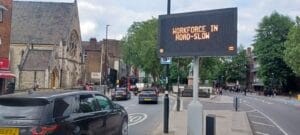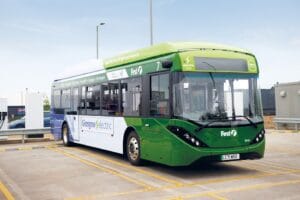A fleet of new, higher specification all-electric buses are being introduced on a bus route in London in a bid to encourage even more people back on to public transport.
The new buses were first developed around two years ago, and Transport for London says they’re a sign of what the future of buses could be if the Government agrees a long term funding deal. It warns that, without a deal, “the less green and increasingly ageing bus fleet will have to remain on the roads”.
TfL is introducing new buses to the north-south route 63 that have a range of features aimed at making them an even more attractive, green alternative to the car. In development over the last couple of years, the first buses came into service in December, with the whole route transformed in the coming weeks. It comes as ridership between on the route, between King’s Cross and Honor Oak, has returned to close to pre-pandemic levels.
The new buses feature USB chargers and mobile phone holders in the seats so that passengers can work or relax more easily as they travel. They have a more open feel – with a skylight on the upper deck, larger rear window, and handles on the backs of seats rather than vertical poles for an unobstructed view. With high back seats throughout journeys will be more comfortable and a wood-effect floor adds to the cutting-edge design.
New covers for the priority seats, with a contrasting colour scheme, help differentiate them from other seats for passengers who are less able to stand. The vehicles also have a larger wheelchair and buggy area, improving accessibility and helping parents getting around town. CCTV cameras have also been upgraded to provide higher-definition footage, making travel even more safe and secure.
The new route 63 buses were manufactured by ADL, the country’s largest bus and coach manufacturer, in Scarborough. ADL employs 2,000 people in skilled jobs, as well as supporting a successful apprenticeship scheme. Other London buses are produced around the UK in places such as Ballymena and Falkirk, demonstrating how investment in the capital’s transport network helps level up the whole country.
Customers expect to have up-to-the-second information about their journey to make instant decisions on the move. New digital signage on board the buses shares a wider range of real-time information, including the time to the next stop, disruptions, and service updates for Tube and Overground services. Later in the year, the route will not only have next bus information at most bus shelters but also new real time information screens at many bus stops.
TfL will use customer feedback from the route 63 to inform plans for the wider bus network, with sustained Government funding essential to enable TfL to continue supporting the city’s economic recovery. Without a funding resolution, these economic advantages, along with the health and environmental benefits of an improved bus network, will not be realised.
(Picture – TfL)


























